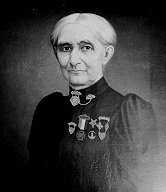

In the local New Hampshire Telegraph, April 27, 1861, it was stated "...An extra blanket, stockings and clothing will save more lives than revolvers." Women would raise money for these needed items through organizing levees. A levee was an evening of dancing, entertainment, and refreshments for which the women would charged admission to. These fundraising events were held before the men were sent south. One such levee in Nashua raised "$315.51, enough to purchase cloth to make 222 shirts and 28 handkerchiefs and towels for the men of Companies C and F of the First Regiment." Throughout the war, the women on the homefront would continue to fundraise money and send off needed supplies to their loved ones.
For some women however, they felt their skills were needed not on the homefront but on the front lines with the soldiers. Two such women were Adelaide Stevens and Harriet Patience Dame. Adelaide would follow her new husband throughout the war wherever duty took him, caring for the soldiers in hospitals and in the field. Harriet Dame would follow the 2nd NH Regiment as a hospital matron to such battle fields as Malvern Hill, 2nd Battle of Manassas, and Gettysburg. She would organize the New Hampshire Relief Association during the war and her portrait was the first portrait of a woman to be hung in the State House of New Hampshire.
The following page is a tribute to these women who have been overlooked by our historians.

 Harriet Patience Dame (1815-1900)
Harriet Patience Dame (1815-1900)
(During the 1st Battle of Manassas)... The Second Regiment of New Hampshire Volunteers' Colonel, Hon. Gilman Marston, who had resigned his seat in the United States Congress for the glory of war, was severely wounded. Overall, the losses to the Second New Hampshire that day were 7 killed, 56 wounded and 46 missing. Nurse Harriet Dame, who had by now caught up with "her boys", had a sudden immersion in the catastrophe of battlefield medicine.
...Between 1861 - 1865 the Second Regiment marched more than 6,000 miles, fought in more than 20 pitched battles, and lost more than 1,000 of the 3,000 men who signed up or were assigned to the Second. Harriet Dame's fame as nurse on the front lines spread far and wide. She repeatedly declined high government office to recruit more nurses; twice captured in battle, she was promptly released with apologies and high praise by her captors.
...After the War the New Hampshire Legislature voted $500 to Miss Dame for extraordinary public service. She used the funds to build a summer cottage for the Second New Hampshire's veterans at The Weirs, a resort town on Lake Winnepesaukee.
|
"She sought no soft place, but wherever her regiment went she went, often marching on foot and camping without tent on the field. She was always present when most needed, and to the suffering, whether Yank or Greyback -it made no difference- she was truly an angel of mercy. Miss Dame was the bravest woman I ever knew. I have seen her face a battery without flinching, while a man took refuge behind her to avoid the flying fragments of bursting shells." - General Gilman Marston commander of the 2nd NH Regiment |
"I can speak of personal knowledge, for I have seen her under fire on many a hard fought field, and when lying on my back shot through the body, unable to move a finger, with, as everybody thought, my last breath going out, and with shot and shell raining around us, as if the very heavens were about to fall, she at that time was indeed to me a ministering angel, and I candidly believe if it were not for her I could nat have written this letter to-day." - M.A. Dillon 2nd NH Regiment wounded at Second Bull Run |
In Dover, Mrs. John P. Hale, President of the Soldiers' Aid Society would hold weekly meetings "to furnish soldiers in service with clothing, hospital stores necessary to health and comfort, when not supplied by the government, and to carefully watch and care for the general well-being of New Hampshire troops, in every possibly particular". After the first meeting on June 13, 1861, the ladies of Dover were able to raise $962.08 over the next six months.
During 1862, the State Aid Society at Concord collected "552quilts, 2003 bedsacks, 1127 sheets, unrecorded number of pillowcases, 1919 cotton and 818 woollen shirts, 882 woollen drawers, 2063 pairs of stockings, 3905 towels and napkins, 4705 handkerchiefs and 21, 768 barrles and jars of miscelaneus contents, beside $3,292.81".
Even towards the end of the War in 1864, the Ladies of Rochester held the Old Folks' Concert conducted by Col. C.S. Whitehouse. This event raised $284.00.
